Vendor Payments using Bank Transfers (AU Only)
Australian businesses typically pay vendors and suppliers directly from their bank accounts, so we have added this capability to our applications in this release. Your business now has the tools to generate an ABA file that you can transmit to your vendor or supplier’s bank to facilitate these payments. While the cheque account settings can be added by a user other than the Branch or Payables Manager, once added, the account-specific entries are only viewable by users with administrative permissions.
Note: The Payables Manager permissions are set in Maintenance > Database > User IDs > Permissions List > Payables list.
Here are the steps for setting up the Bank Transfers process:
-
Establishing the user ID permissions required; this includes permissions for a Branch Manager and a Payables Manager.
-
Setting up the EDI Tie In EDI. Work with your ECI Implementation or Support team to set up these options. Make sure you tell them:
-
The bank you do business with (they need to know so they can choose the right ABA file format)
-
The ABA Bank File name you want them to use.
-
-
Setting up cheque account options for the transmission files (both your own for the branch accounts making the payments and the account settings for your vendors
When you have completed the setup processes, you can process payments easily. Currently, this is only established for Australian businesses.
Setting up the Nightly Process for Bank Transfers
There is an EDI setting called Bank Transfer that sets up the nightly bank transfer process for vendor payments. You also need to set up a secure folder for each branch that will be performing vendor bank transfers. This folder will store the ABA transfer files.
To set up the EDI Tie In:
1. From the Main Menu, choose Maintenance > Database > Parameters to display the Parameter Settings form.
2. Choose the EDI subtab to display the General tab options.
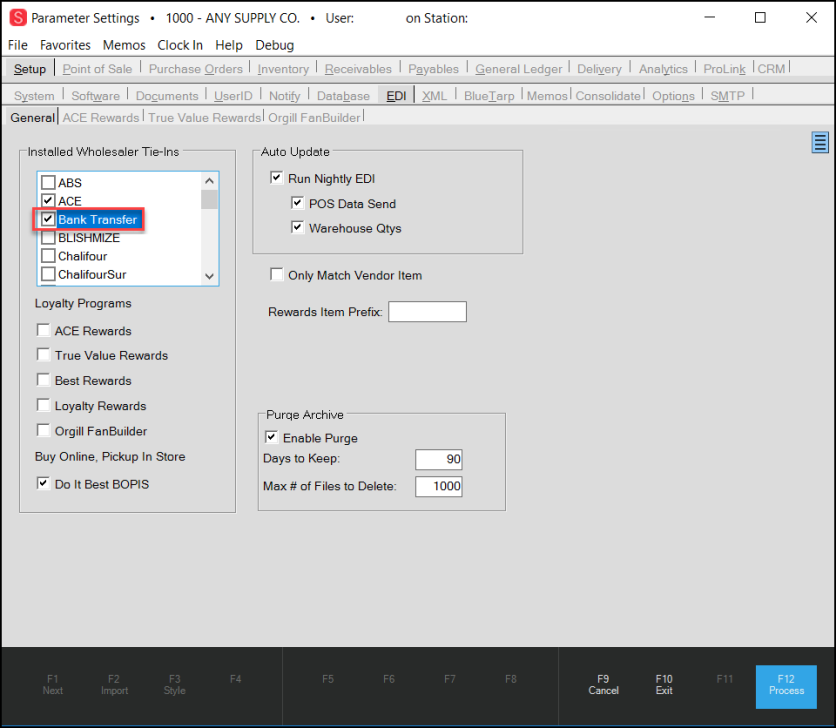
Parameter Settings Form > Setup > EDI > General > Bank Transfer Highlighted
3. In the Installed Wholesaler Tie-Ins section click the Bank Transfer check box.
4. Choose Process (F12) to save this setting.
5. Go back to the Database menu and choose Branches to display the Branch Setup form.
6. From the Branch ID list, choose the branch you want to set up the ABA folder for. The record details display.
7. At the bottom of the form, choose the EDI folder to display the EDI entries.
8. In the Settings for list, choose Bank Transfer to display the available folder options.
9. In the Base Pathname field, choose the Ellipsis  button and select the path the customer wants to choose to save the bank transfer files.
button and select the path the customer wants to choose to save the bank transfer files.
10. Choose Process (F12) to save this entry.
Repeat steps 6 – 10 for each branch that will be performing bank transfers.
Adding Your Bank Settings to Pay Vendors
Before you set up the account settings for vendors, it makes sense that you have added your own settings. The ABA file requires both your file settings and the vendors to ensure a secure transfer.
To add your bank settings to the account:
1. From the Main Menu, choose Payables > Cheque Register to display the Cheque Register form.
2. Beside the Account field, click the Settings ![]() icon to display the Cheque Account Maintenance options. There are some new fields in this list.
icon to display the Cheque Account Maintenance options. There are some new fields in this list.
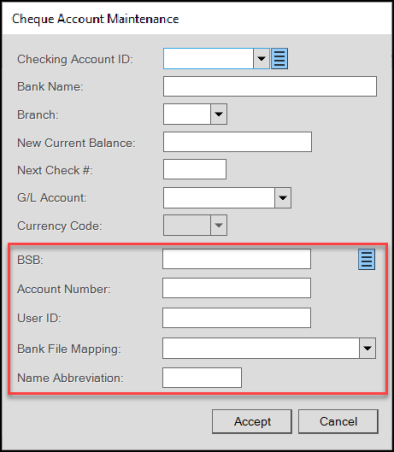
Cheque Account Maintenance with ABA File Specific Fields Highlighted
The Menu Marker allows you to display or hide the text of the entered bank data.
allows you to display or hide the text of the entered bank data.
3. In the Cheque Account Number field, choose the first account you will use to pay vendors from. The entries specific to that account display.
4. In the empty fields, enter the account information specific to this checking account:
-
BSB
Enter the bank routing (BSB) number in this field. -
Account Number
Enter the bank account number you want to pay from. -
User ID
Enter the User ID of the person allowed to perform this task. -
Bank File Mapping
hoose the ABA or ABA-SGE bank file format, depending upon the bank you use to send the payment. -
Name Abbreviation
Enter the name of the account.
5. When you have completed these entries, choose Accept.
6. Choose Process (F12) to save these settings.
Repeat this process for each bank account that you will be paying vendors through bank transfers from.
Adding the Vendor’s Bank Settings
To pay the vendor’s account directly, enter the account details in the new Vendor Maintenance fields. This ensures that when you add a vendor payment to the ABA file, the application routes it to the vendor’s bank account correctly.
To add the vendor’s bank account information to the application:
1. From the Main Menu, choose Purchasing > Database > Vendor to display the Vendor Maintenance form.
2. From the Vendor list, choose the vendor you are adding the bank code information for.
3. Choose the Options tab to display the vendor’s banking detail fields:
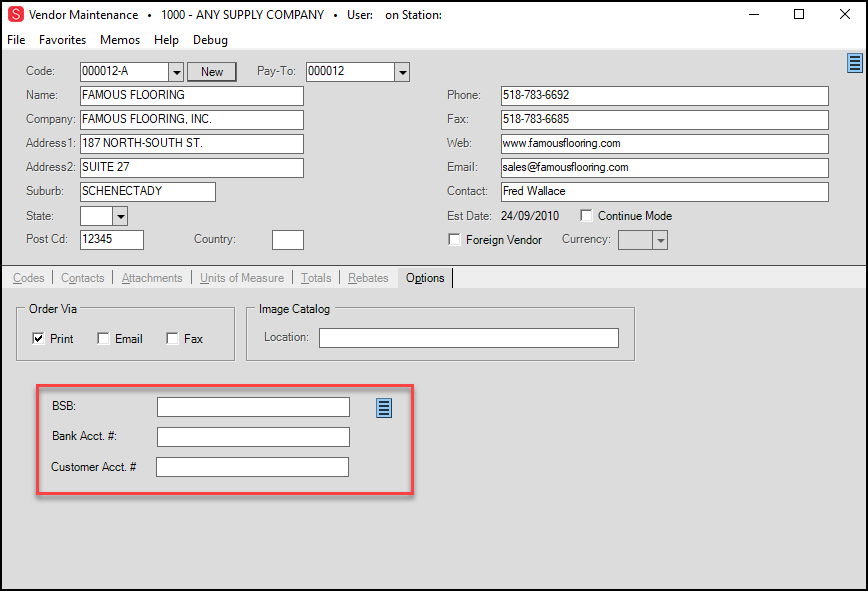
Vendor Maintenance Form > Options Tab > ABA File Entries
The Menu Marker allows you to display or hide the text of the entered bank information. The vendor bank account information is encrypted so that only users with appropriate permissions (Branch and Payables Manager) can see them. Users without these permissions cannot see these entries specifically, but they can change them.
allows you to display or hide the text of the entered bank information. The vendor bank account information is encrypted so that only users with appropriate permissions (Branch and Payables Manager) can see them. Users without these permissions cannot see these entries specifically, but they can change them.
4. In the ABA file fields, enter the vendor’s bank file information:
-
BSB
Enter the vendor’s bank routing number in this field. This entry is usually up to seven characters in Australian banks and has a dash in the middle. This field is known as Bank Store and Branch in Australia. -
Bank Account #
Enter the vendor’s account number in this field. -
Customer Account #
Enter the vendor’s ID with the bank in this field.
5. Choose Process (F12) to save these entries.
Creating an AP Invoice and Paying it with a Bank Transfer
After the setup is complete, you can pay the invoice through the new process as shown below. We assume that the setup for you and for the vendor is complete.
To create an AP Invoice and pay it through the bank transfer process:
1. From the Main Menu, choose Payables > Billing Entry to display the Billing Entry form.
2. From the Vendor Invoice # list, choose the invoice you want to pay.
3. Choose the payment amount and the other settings you normally would in this form and choose Process (F12).
4. Choose Payables > Disbursements to display the check run selection options.
5. From the Cheque Account list, choose an account you set up to pay using bank transfers. A new check box displays.
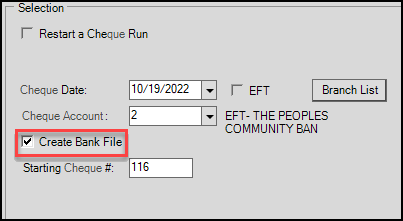
Disbursements > Selection with Create Banks File Check Box
6. Select the Create Bank File check box.
7. Select Process (F12). The application verifies the bank details entered.
-
If the verification process succeeds, the Save As dialog box displays. Continue to the next step.
-
If the verification process fails, a message displays explaining which fields did not validate. Correct those fields in the vendor or your own records, and try the disbursement process again.
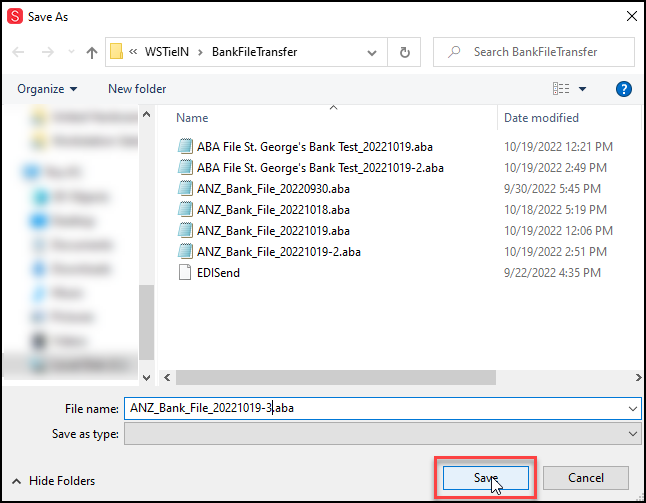
Save As (Bank Transfer Bank File Name)
8. Update the file name, if needed, and choose Save.
The EDI process sends the file(s) you create each day during the nightly upload process.
Note: It is important to distinguish bank files that are processed on the same day so you are not overwriting them. We recommend that you archive these files in case you need to refer to them later.
Processing a Vendor Bank Payment Manually
There is a manual process to run bank transfer payments to vendors manually. This process assumes that you have already created the ABA file.
To send a bank transfer payment to a vendor’s bank manually:
1. From the Main Menu, choose Purchasing > Vendor EDI to display the Vendor EDI Communications form.
2. From the EDI Interface list, choose Bank Transfer.

Vendor EDI Communications > EFT Bank File Selected
3. From the Vendor list, choose the vendor to whom you are sending the payment.
4. In the bullet list, choose the EFT Bank File entry. The list of check run files for the selected vendor displays.
5. From the list, choose the Select check box beside the file you want to process.
6. Choose Transmit (F6) to process the payment. The Save As box displays.
7. Update the bank file name in the field provided as you need to, to ensure that the filename is unique.
8. Choose Save to save the file.
Note: We recommend that you archive these files in case you need to refer to them later.